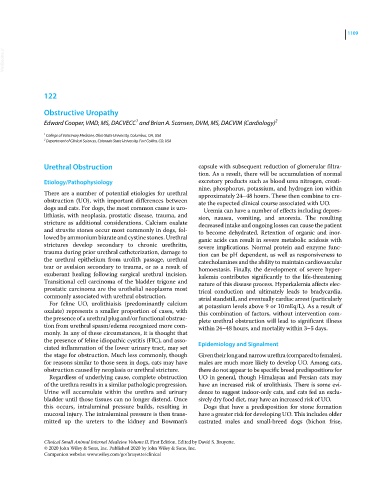Page 1171 - Clinical Small Animal Internal Medicine
P. 1171
1109
VetBooks.ir
122
Obstructive Uropathy
1
Edward Cooper, VMD, MS, DACVECC and Brian A. Scansen, DVM, MS, DACVIM (Cardiology) 2
1 College of Veterinary Medicine, Ohio State University, Columbus, OH, USA
2 Department of Clinical Sciences, Colorado State University, Fort Collins, CO, USA
Urethral Obstruction capsule with subsequent reduction of glomerular filtra
tion. As a result, there will be accumulation of normal
Etiology/Pathophysiology excretory products such as blood urea nitrogen, creati
nine, phosphorus, potassium, and hydrogen ion within
There are a number of potential etiologies for urethral approximately 24–48 hours. These then combine to cre
obstruction (UO), with important differences between ate the expected clinical course associated with UO.
dogs and cats. For dogs, the most common cause is uro Uremia can have a number of effects including depres
lithiasis, with neoplasia, prostatic disease, trauma, and sion, nausea, vomiting, and anorexia. The resulting
stricture as additional considerations. Calcium oxalate decreased intake and ongoing losses can cause the patient
and struvite stones occur most commonly in dogs, fol to become dehydrated. Retention of organic and inor
lowed by ammonium biurate and cystine stones. Urethral ganic acids can result in severe metabolic acidosis with
strictures develop secondary to chronic urethritis, severe implications. Normal protein and enzyme func
trauma during prior urethral catheterization, damage to tion can be pH dependent, as well as responsiveness to
the urethral epithelium from urolith passage, urethral catecholamines and the ability to maintain cardiovascular
tear or avulsion secondary to trauma, or as a result of homoestasis. Finally, the development of severe hyper
exuberant healing following surgical urethral incision. kalemia contributes significantly to the life‐threatening
Transitional cell carcinoma of the bladder trigone and nature of this disease process. Hyper kalemia affects elec
prostatic carcinoma are the urothelial neoplasms most trical conduction and ultimately leads to bradycardia,
commonly associated with urethral obstruction. atrial standstill, and eventually cardiac arrest (particularly
For feline UO, urolithiaisis (predominantly calcium at potassium levels above 9 or 10 mEq/L). As a result of
oxalate) represents a smaller proportion of cases, with this combination of factors, without intervention com
the presence of a urethral plug and/or functional obstruc plete urethral obstruction will lead to significant illness
tion from urethral spasm/edema recognized more com within 24–48 hours, and mortality within 3–5 days.
monly. In any of these circumstances, it is thought that
the presence of feline idiopathic cystitis (FIC), and asso
ciated inflammation of the lower urinary tract, may set Epidemiology and Signalment
the stage for obstruction. Much less commonly, though Given their long and narrow urethra (compared to females),
for reasons similar to those seen in dogs, cats may have males are much more likely to develop UO. Among cats,
obstruction caused by neoplasia or urethral stricture. there do not appear to be specific breed predispositions for
Regardless of underlying cause, complete obstruction UO in general, though Himalayan and Persian cats may
of the urethra results in a similar pathologic progression. have an increased risk of urolithiasis. There is some evi
Urine will accumulate within the urethra and urinary dence to suggest indoor‐only cats, and cats fed an exclu
bladder until those tissues can no longer distend. Once sively dry food diet, may have an increased risk of UO.
this occurs, intraluminal pressure builds, resulting in Dogs that have a predisposition for stone formation
mucosal injury. The intraluminal pressure is then trans have a greater risk for developing UO. This includes older
mitted up the ureters to the kidney and Bowman’s castrated males and small‐breed dogs (bichon frise,
Clinical Small Animal Internal Medicine Volume II, First Edition. Edited by David S. Bruyette.
© 2020 John Wiley & Sons, Inc. Published 2020 by John Wiley & Sons, Inc.
Companion website: www.wiley.com/go/bruyette/clinical

